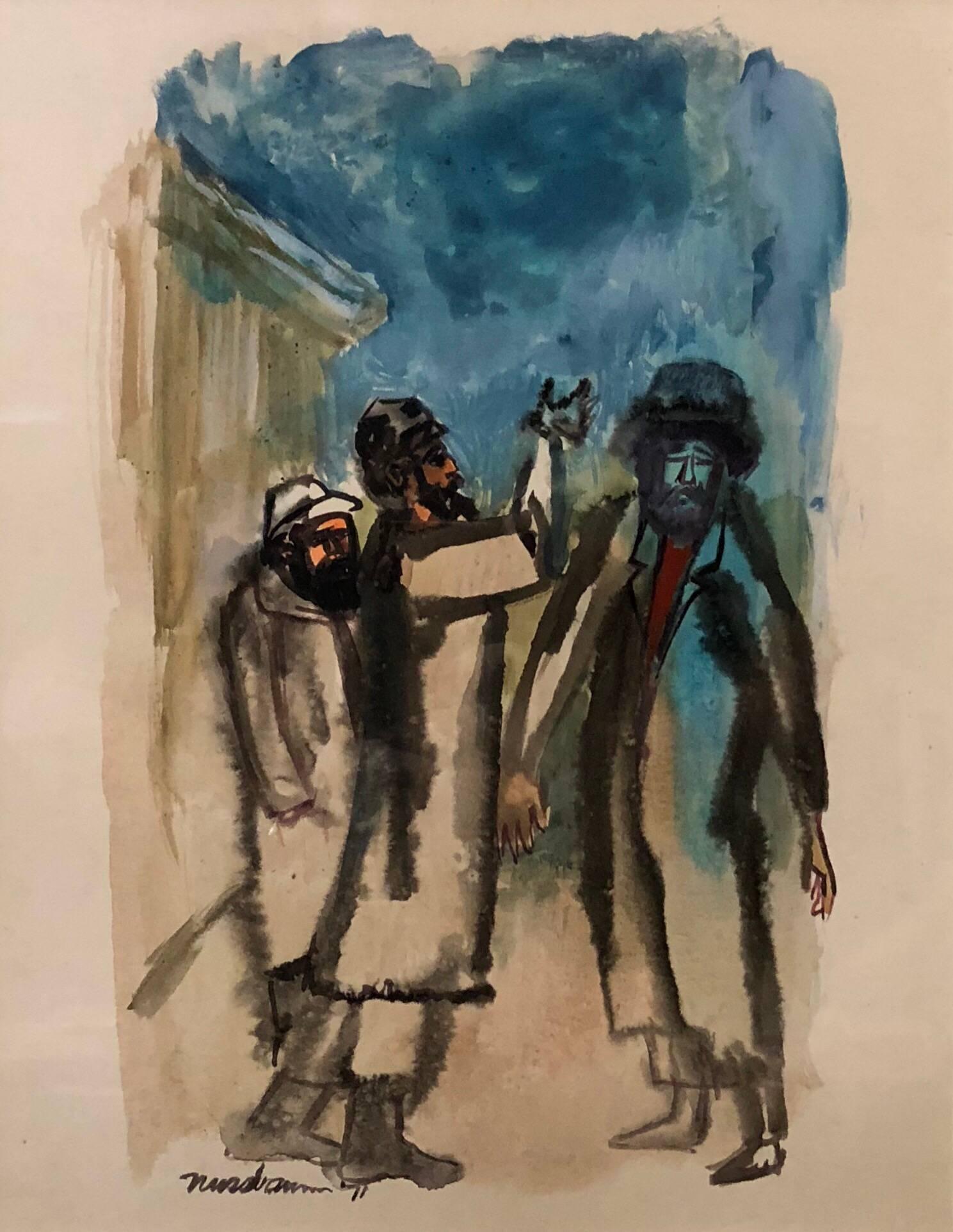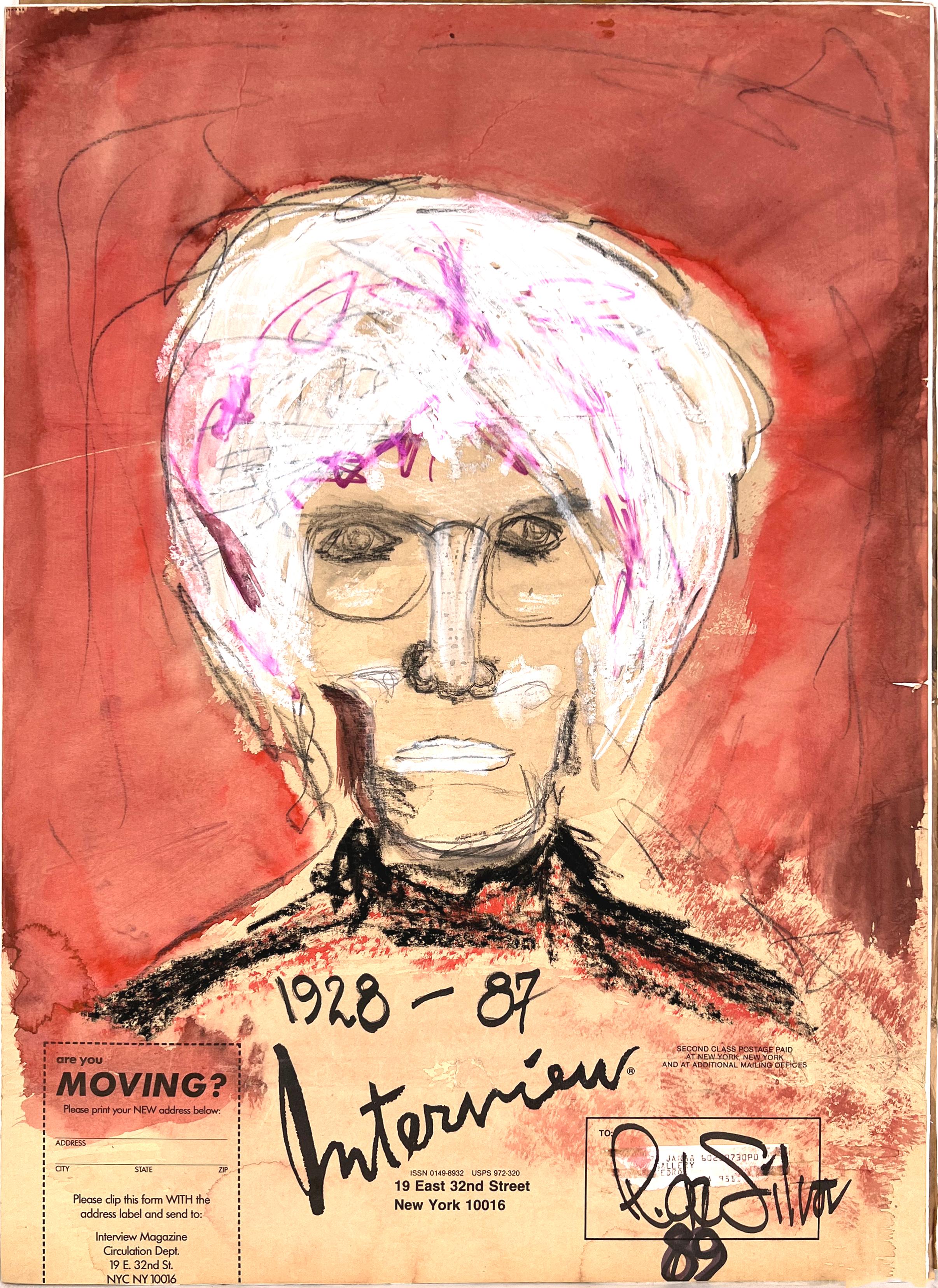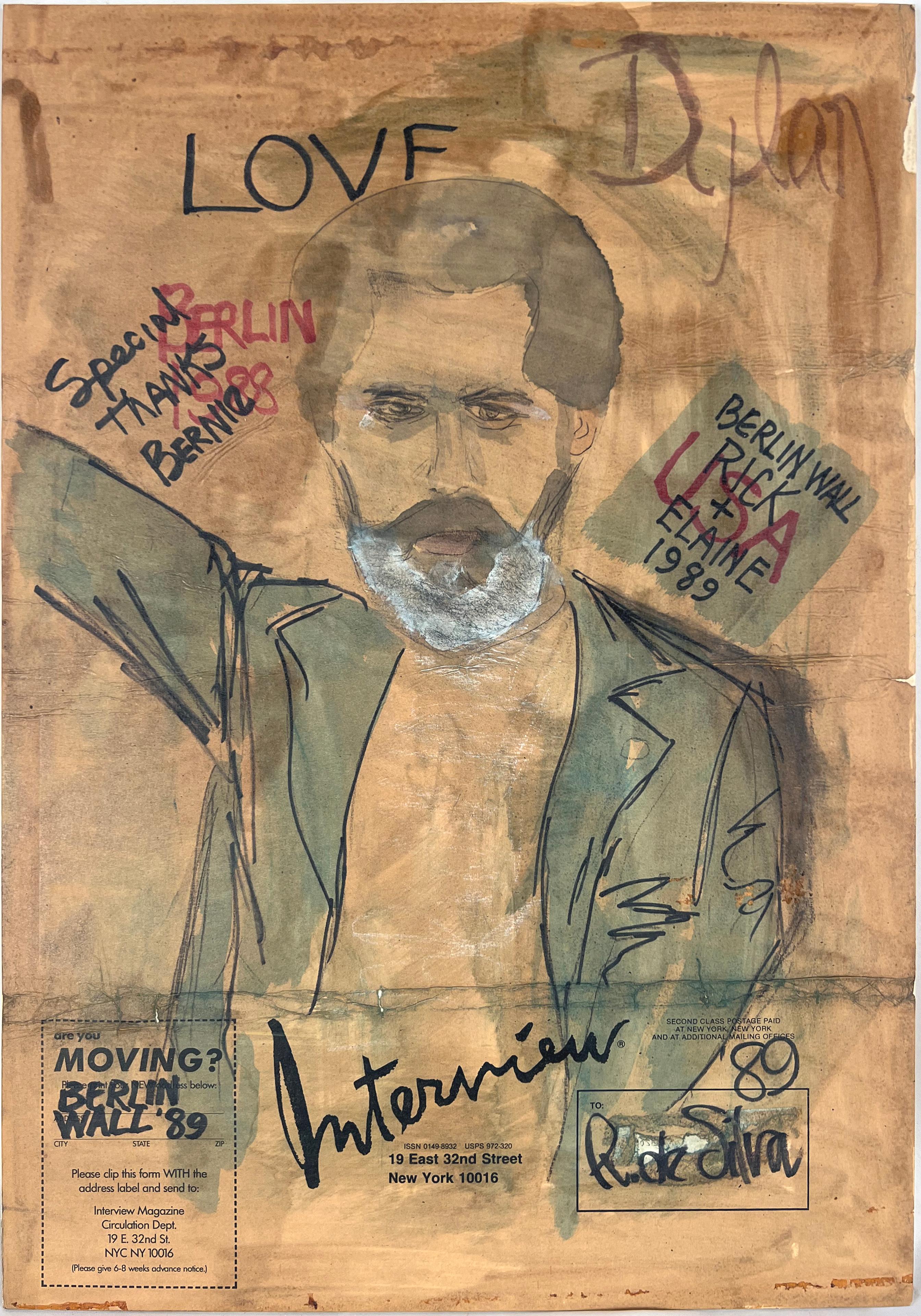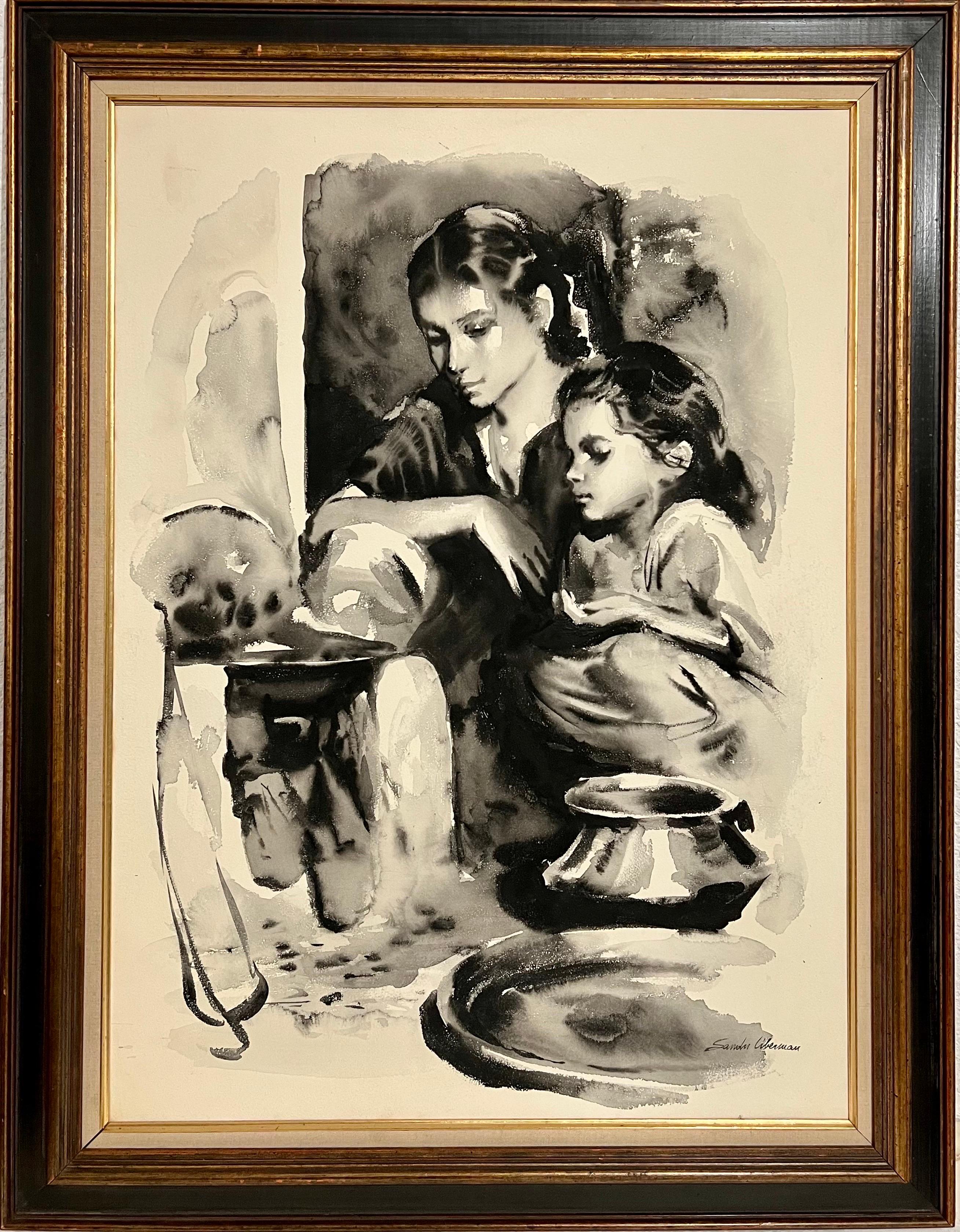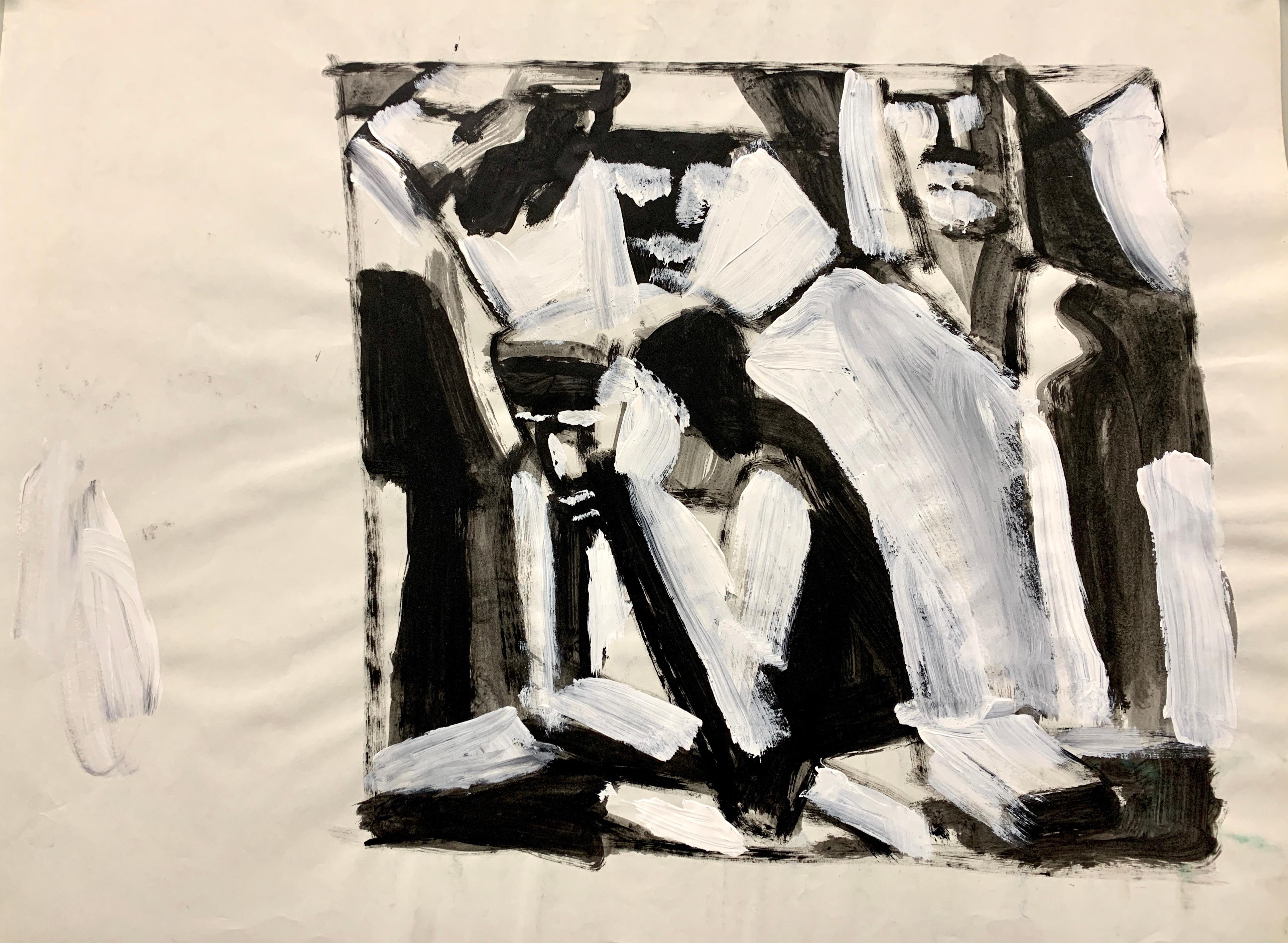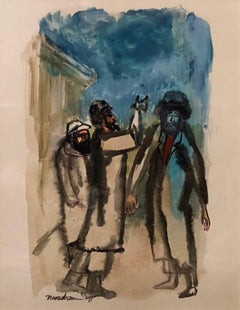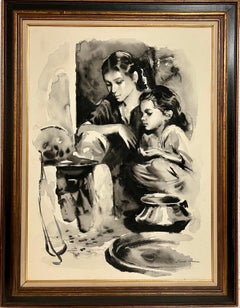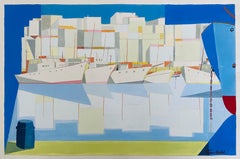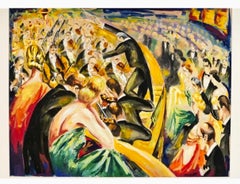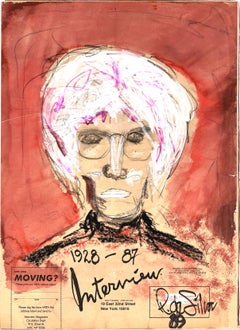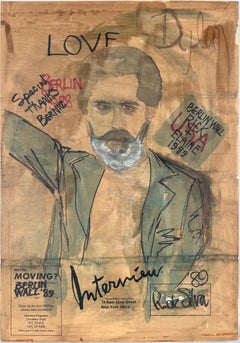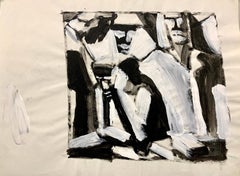Items Similar to Family of Three, Mid Century Gouache on Paper
Want more images or videos?
Request additional images or videos from the seller
1 of 7
Ivan KurachFamily of Three, Mid Century Gouache on Paper
About the Item
Ivan Kurach (1909 – 1968) lived and studied in Italy.
Well known both in Europe and in the United States, his paintings are found in famous private collections and in museums all over the world. He spent most of his time between his studios of New York City and Milan, Italy. His work is another example of how very modern technique and sensitivity can freely fuse into the rigid rule of the most beautiful Italian pictorial tradition.
A soldier in World War II, he was a faithful interpreter of that tragic period; with gray and somber colors, with sad visions, he portrayed those days with force and meaning.
- Creator:Ivan Kurach (1909 - 1968, Swiss, Ukrainian)
- Dimensions:Height: 19.5 in (49.53 cm)Width: 15.75 in (40.01 cm)
- Medium:
- Movement & Style:
- Period:
- Condition:
- Gallery Location:Surfside, FL
- Reference Number:1stDibs: LU38211513942
About the Seller
4.9
Platinum Seller
Premium sellers with a 4.7+ rating and 24-hour response times
Established in 1995
1stDibs seller since 2014
1,744 sales on 1stDibs
Typical response time: 2 hours
- ShippingRetrieving quote...Shipping from: Surfside, FL
- Return Policy
Authenticity Guarantee
In the unlikely event there’s an issue with an item’s authenticity, contact us within 1 year for a full refund. DetailsMoney-Back Guarantee
If your item is not as described, is damaged in transit, or does not arrive, contact us within 7 days for a full refund. Details24-Hour Cancellation
You have a 24-hour grace period in which to reconsider your purchase, with no questions asked.Vetted Professional Sellers
Our world-class sellers must adhere to strict standards for service and quality, maintaining the integrity of our listings.Price-Match Guarantee
If you find that a seller listed the same item for a lower price elsewhere, we’ll match it.Trusted Global Delivery
Our best-in-class carrier network provides specialized shipping options worldwide, including custom delivery.More From This Seller
View AllModernist American Judaica Painting Rabbis in Conversation
By Ervin B. Nussbaum
Located in Surfside, FL
In this painting, Nussbaum portrays Rabbi in lively conversation outside the synagogue in a sketch-like manner without focusing on any specific details. The vibrant colors used in th...
Category
1970s Modern Figurative Paintings
Materials
Paper, Watercolor, Gouache
Large Gouache Original Painting Mother & Daughter Sandu Liberman Israeli Judaica
By Sandu Liberman
Located in Surfside, FL
framed 36 X 28 board 30 X 21.75
Sandu Liberman (Romanian-Israeli) was born in Yasi, Romania in 1923. between 1946 and 1953 he took part in the state art shows in Bucharest. in 1952 ...
Category
20th Century Modern Figurative Paintings
Materials
Paper, Gouache
Romanian Modernist Gouache Painting Of Buildings And Boats - Jean David
By Jean David
Located in Surfside, FL
Jean David was a painter and designer, known for his contributions to the Romanian avant-garde and to the early modernist art of Israel (then recently founded). He was the first Israeli artist to be inducted into the illustrious Alliance Graphique Nationale in 1954.
He had studied between 1927 and 1937 at various art academies in Paris. In 1929 he participated for the first time at a collective exhibition in Bucharest and in 1933 he had his first personal exhibition (in the same city). In the early '30s he was a member of the Surrealist group "unu" (meaning "one"). In 1942, he left Romania in a boat with 12 other Jews, including Theodor Brauner, the brother of Victor Brauner. After being captured by British authorities in Cyprus, he managed to reach Palestine in 1944. In 1949 he went to live in Jerusalem, where he was active in developing ceramic arts, sculpture works in copper, and artistic tapestry wall hangings under the auspices of the Ministry of Trade and Industry. Together with Marcel Janco, he founded in Israel the artist village known as Ein Hod. He also gained much reputation as a muralist and graphic and poster designer, having designed numerous posters and other works for the El Al air company, Maccabiah games, Zim shipping and The Israel tourist industry. David’s primary importance was in the design of posters. He used a wildly colorful decorative style in his art, which combined illustration, caricature, and national figures. In addition he designed wall hangings for “Maskit,” and also worked in the decoration of public buildings. His paintings had elements of Surrealism and included images from nature and landscapes. Similar in style to David Klein and the Polish Cyrk posters.
Forms From Israel, Mounting Exhibition, USA, 1958 Artists: El Hanani (Sapozhnikow), Arie Azaz, Nehemiah Boris Carmi, Hanna Harag Zunz, David, Jean David Gumbel, Keiner Forcheimer, Julia Mansfeld, Al Merom, Peter Mayer, Jean Palombo...
Category
Mid-20th Century Modern Figurative Paintings
Materials
Paper, Gouache
Large Tel Aviv Orchestra Israeli Bezalel School Modernist Painting Moshe Matus
By Moshe Matus (Matusovsky)
Located in Surfside, FL
Moshe (Matusovski) Matus (Polish Israeli , 1908-1958),
Depicting an orchestral concert.
Hand signed lower right.
Dimensions: (Frame) H 31" x W 37", (Sight) H 21" x W 28"
Moshe Matus (Matusovski) 1908, Warsaw, Russian Poland - November 23, 1958 Toronto, Canada. was a Polish Israeli modernist painter who lived during the last decade of his life in The United States and Canada. Matus was born in 1908 in the Russian city of Warsaw, into a traditional and Zionist family, the eldest of the three children of Dr. Josef Matusovsky, a dentist, and was a member of Hashomer Hatzair in Warsaw in 1924. When he was 15, He studied at the Bezalel Academy of Art and Design in the 1920s with Boris Schatz and was educated at the Herzliya Gymnasium where he studied painting and sculpture. He studied for several years at École nationale supérieure des Beaux-Arts (Bose-R) in Paris. He returned to Tel Aviv and lived there on Sheinkin Street. From the 30s was one of the most prominent artists in the country. he exhibited In shows general as well as in solo shows - which exhibition at the Herzliya in Tel Aviv, which opened Benzion friends (1932); in Allenby 15, Tel Aviv (1935) exhibition in Pomrock , which opened the poet Saul Tchernichovsky and Moses (1936), at the Steimatzky Gallery in Jerusalem , opened by Dr. Moshe Duchan (March 23, 1937); An exhibition at the Cosmopolitan Gallery in Tel Aviv (formerly the Bach Gallery, 1 Hess Street), opened by Mayor Israel Rokach (March 5, 1938); and an exhibition at the Tel Aviv Museum (1946).
He painted the stage...
Category
1930s Modern Figurative Paintings
Materials
Paper, Gouache
Rare Modernist Hungarian Rabbi Pastel Drawing Gouache Painting Judaica Art Deco
By Hugó Scheiber
Located in Surfside, FL
Rabbi in the synagogue at prayer wearing tallit and tefillin.
Hugó Scheiber (born 29 September 1873 in Budapest – died there 7 March 1950) was a Hungarian modernist painter.
Hugo Scheiber was brought from Budapest to Vienna at the age of eight where his father worked as a sign painter for the Prater Theater. At fifteen, he returned with his family to Budapest and began working during the day to help support them and attending painting classes at the School of Design in the evening, where Henrik Papp was one of his teachers. He completed his studies in 1900. His work was at first in a post-Impressionistic style but from 1910 onward showed his increasing interest in German Expressionism and Futurism. This made it of little interest to the conservative Hungarian art establishment.
However, in 1915 he met the great Italian avant-gardist Filippo Tommaso Marinetti and the two painters became close friends. Marinetti invited him to join the Futurist Movement. The uniquely modernist style that he developed was, however, closer to German Expressionism than to Futurism and eventually drifted toward an international art deco manner similar to Erté's. In 1919, he and his friend Béla Kádar held an exhibition at the Hevesy Salon in Vienna. It was a great success and at last caused the Budapest Art Museum to acquire some of Scheiber's drawings. Encouraged, Scheiber came back to live in Vienna in 1920.
A turning point in Scheiber's career came a year later, when Herwarth Walden, founder of Germany's leading avant-garde periodical, Der Sturm, and of the Sturm Gallery in Berlin, became interested in Scheiber's work. Scheiber moved to Berlin in 1922, and his paintings soon appeared regularly in Walden's magazine and elsewhere. Exhibitions of his work followed in London, Rome, La Paz, and New York.
Scheiber's move to Germany coincided with a significant exodus of Hungarian artists to Berlin, including Laszlo Moholy-Nagy and Sandor Bortnyik. There had been a major split in ideology among the Hungarian avant-garde. The Constructivist and leader of the Hungarian avantgarde, Lajos Kassák (painted by Hugó Scheiber in 1930) believed that art should relate to all the needs of contemporary humankind. Thus he refused to compromise the purity of his style to reflect the demands of either the ruling class or socialists and communists. The other camp believed that an artist should be a figurehead for social and political change.
The fall out and factions that resulted from this politicisation resulted in most of the Hungarian avant gardists leaving Vienna for Berlin. Hungarian émigrés made up one of the largest minority groups in the German capital and the influx of their painters had a significant effect on Hungarian and international art. Another turning point of Scheiber's career came in 1926, with the New York exhibition of the Société Anonyme, organized by Katherine Dreier. Scheiber and other important avant garde artists from more than twenty-three countries were represented. In 1933, Scheiber was invited by Marinetti to participate in the great meeting of the Futurists held in Rome in late April 1933, Mostra Nazionale d’Arte Futurista where he was received with great enthusiasm. Gradually, the Hungarian artists began to return home, particularly with the rise of Nazism in Germany. Kádar went back from Berlin in about 1932 and Scheiber followed in 1934.
He was then at the peak of his powers and had a special flair in depicting café and cabaret life in vivid colors, sturdily abstracted forms and spontaneous brush strokes. Scheiber depicted cosmopolitan modern life using stylized shapes and expressive colors. His preferred subjects were cabaret and street scenes, jazz musicians, flappers, and a series of self-portraits (usually with a cigar). his principal media being gouache and oil. He was a member of the prestigious New Society of Artists (KUT—Képzőművészek Új Társasága)and seems to have weathered Hungary's post–World War II transition to state-communism without difficulty. He continued to be well regarded, eventually even receiving the posthumous honor of having one of his images used for a Russian Soviet postage stamp (see image above). Hugó Scheiber died in Budapest in 1950.
Paintings by Hugó Scheiber form part of permanent museum collections in Budapest (Hungarian National Museum), Pecs (Jannus Pannonius Museum), Vienna, New York, Bern and elsewhere. His work has also been shown in many important exhibitions, including:
"The Nell Walden Collection," Kunsthaus Zürich (1945)
"Collection of the Société Anonyme," Yale University Art Gallery, New Haven, Connecticut (1950)
"Hugó Scheiber: A Commemorative Exhibition," Hungarian National Museum, Budapest (1964)
"Ungarische Avantgarde," Galleria del Levante, Munich (1971)
"Paris-Berlin 1900-1930," Centre Georges Pompidou, Paris (1978)
"L’Art en Hongrie, 1905-1920," Musée d’Art et l’Industrie, Saint-Etienne (1980)
"Ungarische Avantgarde in der Weimarer Republik," Marburg (1986)
"Modernizmus," Eresz & Maklary Gallery, Budapest (2006)
"Hugó Scheiber & Béla Kádár," Galerie le Minotaure, Paris and Tel Aviv (2007)
Hugó Scheiber's paintings continue to be regularly sold at Sotheby's, Christie's, Gillen's Arts (London), Papillon Gallery (Los Angeles) and other auction houses.
He was included in the exhibition The Art Of Modern Hungary 1931 and other exhibitions along with Vilmos Novak Aba, Count Julius Batthyany, Pal Bor, Bela Buky, Denes Csanky, Istvan Csok, Bela Czobel, Peter Di Gabor, Bela Ivanyi Grunwald, Baron Ferenc Hatvany, Lipot Herman, Odon Marffy, C. Pal Molnar...
Category
Early 20th Century Modern Figurative Paintings
Materials
Paper, Charcoal, Pastel, Watercolor, Gouache
Chicago Jewish Modernist Judaica Painting Simchat Torah WPA Artist Israeli Flags
By Alexander Raymond Katz
Located in Surfside, FL
This has young ISraeli pioneers dancing with the flag as typical of works of the late British mandate Palestine era early state of Israel.
Genre: Modern
Subject: Figurative (stained glass style)
Medium: Mixed media gouache on paper
Hand signed lower left
Alexander Raymond Katz, Hungarian / American (1895 – 1974)
Alexander Raymond Katz was born in Kassa, Hungary, and came to the United States in 1909. He studied at the Art Institute of Chicago and the Chicago Academy of Fine Arts. In the late 1920s, he worked as a director of the Poster Department at Paramount Studios. He was appointed the Director of Posters for the Chicago Civic Opera in 1930.
During the Great Depression, notable architect Frank Lloyd Wright urged Katz to become a muralist. In 1933, he was commissioned to paint a mural for the Century of Progress exposition in Chicago. In 1936, he painted the mural History of the Immigrant for the Madison, Ill., post office. Katz’s works were included in various exhibitions and now are part of several museum collections, including those of the Art Institute of Chicago; Corcoran Gallery of Art, Washington, D.C.; and the Jewish Museum, New York. His murals, bas-reliefs and stained glass designs adorn more than 200 Jewish synagogues in the United States.
Katz and other Jewish artists in Chicago who expressed Jewish and Biblical themes were inspired by the artist Abel Pann (1883-1963). Pann, who is regarded as the leading painter of the Land of Israel, exhibited in the Art Institute of Chicago in 1920.
Early in his career, Katz began to explore the artistic possibilities inherent in the characters of the Hebrew alphabet. He developed aesthetic and philosophical interpretations of each letter and became the leading innovator and pioneer in the field of Hebraic art.
Katz applies this concept in the woodcut Moses and the Burning Bush. Hebrew letters appears in Moses’ head, his cane and inside the flame. The initial of Moses’ name crowns his head. The letter in the flame is the first letter of the name of God. A combination of images and Hebrew letters appeared commonly in illustrations of the scene Moses and the Burning Bush in the Haggadah, the book of Passover.
The symbolism of the burning bush corresponds to the motifs of A Gift to Biro-Bidjan. Among the fourteen participating artists were notable Chicago modernists Todros Geller, Mitchell Siporin...
Category
Mid-20th Century Modern Figurative Paintings
Materials
Paper, Gouache
You May Also Like
Andy Warhol Gouache on Interview Magazine Back Page 1989 Modernism
Located in Soquel, CA
Andy Warhol Gouache on Interview Magazine Back Page 1989 Modernism
Portrait of Andy Worhol on Andy Worhol's Interview Magazine back page and painted over in Gouache by Ricardo (Richa...
Category
1980s Modern Figurative Paintings
Materials
Paper, Gouache
$920 Sale Price
20% Off
The Berlin Wall in Gouache on Interview Magazine Back Page 1989 Modernism
Located in Soquel, CA
Artist in Gouache on Interview Magazine Back Page 1989 Modernism
Portrait of a man and commemorating The Fall of the Berlin Wall on Andy Worhol's Interview Magazine back page and pai...
Category
1980s Modern Figurative Paintings
Materials
Paper, Gouache
1950s "Group Meeting" Mid Century Figurative Gouache University of Paris
By Donald Stacy
Located in Arp, TX
Donald Stacy
"Group Meeting"
c.1950s
Gouache paint on paper
24" x 18'" unframed
Unsigned
Came from artist's estate
Donald Stacy (1925-2011) New Jersey
Studied: Newark School of Fin...
Category
Mid-20th Century American Modern Figurative Paintings
Materials
Paper, Gouache
Still Life with Flowers and Fruit
Located in London, GB
'Still Life with Flowers and Fruit', gouache on art paper, by French artist, Michel Debiève (1964). As is usual with this artist, the joy is in the detail he has rendered. What is no...
Category
1960s Modern Still-life Paintings
Materials
Paper, Gouache
$1,303 Sale Price
20% Off
1950s "Shapes with Figure" Mid Century Cubist Nude Gouache Painting
Located in Arp, TX
From the estate of Jerry Opper & Ruth Friedmann Opper
Shapes with Figure
c. 1950's
Gouache on paper
15" x 18", Unframed
From the estate of Ruth Friedmann Opper & Jerry Opper. Ruth was the daughter of Bauhaus artist, Gustav Friedmann.
San Francisco Abstract Expression
A free-spirited wave of creative energy swept through the San Francisco art community after World War II. Challenging accepted modes of painting, Abstract Expressionists produced highly experimental works that jolted the public out of its postwar complacency.
Abstract Expressionism resulted from a broad collective impulse rather than the inspiration of a small band of New York artists. Documenting the interchanges between the East and West Coasts, she cites areas of mutual influence and shows the impact of San Francisco on the New York School, including artists such as Mark Rothko and Ad Reinhardt. San Francisco's Beat poets...
Category
Mid-20th Century American Modern Figurative Paintings
Materials
Paper, Gouache
1950s "Pink Towel 2" Mid Century Nude Gouache Painting
Located in Arp, TX
From the estate of Jerry Opper & Ruth Friedman Opper
Yellow
c. 1950's
Gouache on Paper
15" x 18", Unframed
*Custom framing available for additional charge. Please expect framing time between 3-5 weeks.
From the estate of Ruth Friedmann Opper & Jerry Opper. Ruth was the daughter of Bauhaus artist, Gustav Friedmann.
San Francisco Abstract Expression
A free-spirited wave of creative energy swept through the San Francisco art community after World War II. Challenging accepted modes of painting, Abstract Expressionists produced highly experimental works that jolted the public out of its postwar complacency.
Abstract Expressionism resulted from a broad collective impulse rather than the inspiration of a small band of New York artists. Documenting the interchanges between the East and West Coasts, she cites areas of mutual influence and shows the impact of San Francisco on the New York School, including artists such as Mark Rothko and Ad Reinhardt. San Francisco's Beat poets...
Category
Mid-20th Century American Modern Figurative Paintings
Materials
Paper, Gouache
